 |

MBL Catalyst, Volume 6, Number 2, Fall 2011
Download the full issue (PDF)
Fall 2011 Supplementary Materials
Click here for photo captions and links for the Fall 2011 issue of Catalyst.
Pp. 2-3: A Beacon for Science
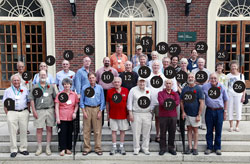 MBL Whitman Investigators gathered for a reception in July 2011 to celebrate the rich tradition of biological discovery that they are carrying into the future. Several of those in attendance have had a laboratory at the MBL for the past 20 years or more; they are pictured at left with MBL President and Director Gary Borisy and Chief Academic and Scientific Officer Joshua Hamilton. Click here to see the full size image and list of names. MBL Whitman Investigators gathered for a reception in July 2011 to celebrate the rich tradition of biological discovery that they are carrying into the future. Several of those in attendance have had a laboratory at the MBL for the past 20 years or more; they are pictured at left with MBL President and Director Gary Borisy and Chief Academic and Scientific Officer Joshua Hamilton. Click here to see the full size image and list of names.
|
|
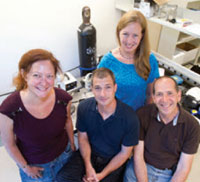 Pp. 4-5: To Regenerate or Not? That is the Question Pp. 4-5: To Regenerate or Not? That is the Question
Smith, J., Morgan, J.R., Zottoli, S.J., Smith, P.J., Buxbaum, J.D., and Bloom, O.E. (2011) Regeneration in the Era of Functional Genomics and Gene Network Analysis. Biol. Bull 221:18-34. [PDF attached]
Video of larval sea lamprey swimming in tank in Morgan/Bloom Whitman Center lab
|
|
Pp. 6-7: News and Notes: Recent Discoveries from the Whitman Center for Research and Discovery
 Tinnitus Caused by Too Little Inhibition of Brain Auditory Circuits, Study Finds Tinnitus Caused by Too Little Inhibition of Brain Auditory Circuits, Study Finds
Middleton, J.W., Kiritani, T., Pedersen, C., Turner, J.G., Shepherd, G.M.G., and Tzounopoulos, T. (2011) Mice with behavioral evidence of tinnitus exhibit dorsal cochlear nucleus hyperactivity because of decreased GABAergic inhibition. PNAS 108: 7601-7606. [PDF attached]
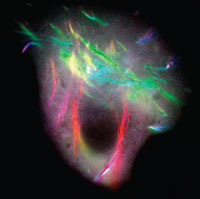 New Microscopy System Illuminates Organization of Key Cellular Protein
New Microscopy System Illuminates Organization of Key Cellular Protein
DeMay, B.S., Bai, X., Howard, L., Occhipinti, P., Meseroll, R.A., Spiliotis, E.T., Oldenbourg, R., and Gladfelter, A.S. (2011) Septin filaments exhibit a dynamic, paired organization that is conserved from yeast to mammals. J. Cell Biol. 193: 1065–1081. [PDF attached]
Scientists Observe New Force During Cell Cycle
Field, C.M., Wühr, M., Anderson, G.A., Kueh, H.Y., Strickland, D., and
Mitchison, T.J. (2011) Actin behavior in bulk cytoplasm is cell cycle regulated in early vertebrate embryos. J Cell Sci. 124:2086-95. [PDF Attached]
 What Fish Tell Us About Vocal Communication
What Fish Tell Us About Vocal Communication
Chagnaud, B.P., Baker, R., and Bass, A.H. (2011) Vocalization frequency and duration are coded in separate hindbrain nuclei. Nature Comm. 2:346. [PDF attached]
Study Provides Insight into Insulin Release from Pancreatic Beta Cells
Gray, J.P., Eisen, T., Cline, G.W., Smith, P.J.S., and Heart, E. (2011) Plasma membrane electron transport in pancreatic beta-cells is mediated in part by NQO1. Am J Physiol Endocrinol Metab 301: E113–E121. [PDF attached]
|
|
Pp. 8-9: The Visionaries: Pioneers in Super-Resolution Microscopy Push the Limits of the Knowable
Galbraith, C.G. and Galbraith, J.A. (2011) Super-resolution microscopy at a glance. J. Cell Sci. 124: 1607-1611. [PDF attached]
Michalowski, J. Have Microscope, Will Travel. HHMI Bulletin, November 2011. [PDF attached]
Planchon, T.A., Gao, L., Milkie, D.E., Davidson, M.W., Galbraith, J.A., Galbraith, C.G., and Betzig, E. (2011) Rapid three-dimensional isotropic imaging of living cells using Bessel beam plane illumination. Nature Methods 8: 417-423. [PDF attached]
Simonson, P.D., Rothernberg, E., and Selvin, P.R. (2011) Single-Molecule-Based Super-Resolution Images in the Presence of Multiple Fluorophores. Nano Lett.11, 5090–5096. [PDF attached]
 Stanley, S. and Kenney, D. MBL courses test ‘bleeding edge microscope’. @MBL, July 20, 2010. Video interview with E. Betzig and movies made with Bessel beam plane illumination microscope. http://blog.mbl.edu/?p=995
Stanley, S. and Kenney, D. MBL courses test ‘bleeding edge microscope’. @MBL, July 20, 2010. Video interview with E. Betzig and movies made with Bessel beam plane illumination microscope. http://blog.mbl.edu/?p=995
Other videos of Bessel beam plane illumination microscopy:
http://www.youtube.com/watch?v=Rl-z76LjQzw (Mitosis)
http://www.youtube.com/watch?v=EnIPt5Vuf9c (3D Architecture of African green monkey kidney cell)
|
|
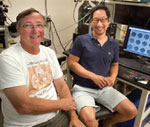 pp. 10-11: The Geometry of Life pp. 10-11: The Geometry of Life
Minc, N., Burgess, D., and Chang, F. (2011) Influence of Cell Geometry on Division-Plane Positioning. Cell 144, 414–426. [PDF attached]
Shah, J. (2010) Cells in tight spaces: the role of cell shape in cell function. J. Cell Biol. 191: 233-236. [PDF attached]
Wuhr, M., Tan, E.S., Parker, S.K., Detrich, H.W., and Mitchison, T.J. (2010). A Model for Cleavage Plane Determination in Early Amphibian and Fish Embryos. Curr. Biol. 20: 2040-2045. [PDF attached] (Research partially conducted in MBL Physiology course).
|
|
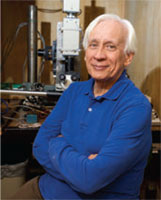 Pp. 12-13: How the Squid Offered Deep Insight into Alzheimer’s Disease Pp. 12-13: How the Squid Offered Deep Insight into Alzheimer’s Disease
Selected Discoveries by Rodolfo Llinás and Collaborators at the MBL
On Synaptic Transmission in the Squid, Loligo Paelei, and the Mechanism of Alzheimer’s Disease
1966: First demonstration that synaptic transmission can occur in the absence of action potentials (Nature 212: 49-50) [PDF attached]
1976: First voltage-clamp studies on squid synapse determine the kinetics and voltage dependence of calcium currents that trigger transmitter release (PNAS 73: 2918-2922) [PDF attached]
1990: With 2000 Nobel Laureate Paul Greengard, identification of molecules in synapse that regulate neurotransmitter release. (PNAS 87: 8257-8261) [PDF attached]
1992: Using the jellyfish protein aequorin provided by MBL scientist and 2008 Nobel Laureate Osamu Shimomura, first demonstration of microdomains of high calcium concentration in a presynaptic terminal (Science 256: 677-679)
2009: Injections of amyloid beta (a protein implicated in the generation of Alzheimer’s disease,) block synaptic transmission in the squid (PNAS 106: 5901-5906) [PDF attached]
2009: Method developed to deliver drugs orally to the squid (Biol. Bull. 216: 1-6) [PDF attached]
2011: Demonstration of the blocking effects of human tau protein (abnormal aggregations of which are a hallmark of Alzheimer’s disease) on squid giant synapse transmission; prevention of those blocking effects by a chemical agent (Front. Synaptic Neuro. 3:1-8) [PDF attached]
|
|
P. 15: Opening a Portal on the Behavior of Jellies
Katija, J., Colin, S.P., Costello, J.H., and Dabiri, J.O. Quantitatively Measuring In situ Flow Using a Self-Contained Underwater Velocimetry Apparatus (SCUVA). J. Visualized Experiments, Oct. 31, 2011. [PDF attached]
Video link to JOVE article:
“Underwater Video Camera (SCUVA) Opens Window Into Behavior of Jellies,” video by Amanda Rose Martinez
|
|
 p. 16: Placing a Value on the Invaluable p. 16: Placing a Value on the Invaluable
Selected historical treatments on the research contributions of MBL “summer” and Whitman investigators:
Allen, Garland. T.H. Morgan, the Man and His Science. Princeton, NJ: Princeton University Press, 1978.
Allen, Garland. Life Science in the Twentieth Century. Cambridge: Cambridge University Press, 1975, 1978.
Barlow, Robert B., John E. Dowling, and Gerald Weissmann, eds. The Biological Century: Friday Evening Talks at the Marine Biological Laboratory. Woods Hole: The Marine Biological Laboratory, 1993. ISBN 0-674-07403-3
Kenney, D.E. and Borisy, G.G. (2009) Thomas Hunt Morgan at the Marine Biological Laboratory: Naturalist and Experimentalist. Genetics 181: 841-846. [PDF attached]
Lillie, Frank R. The Woods Hole Marine Biological Laboratory. Chicago: University Press, 1944. Reprinted in Biol. Bull. (1988) 174 (suppl.).
Llinas, Rodolfo. The Squid Giant Synapse. New York and Oxford: Oxford University Press, 1999. ISBN 0-19-511652-6
Maienschein, Jane. One Hundred Years Exploring Life, 1888-1988: The Marine Biological Laboratory at Woods Hole. Boston: Jones and Bartlett Publishers, 1989. ISBN 0- 86720-120-7
Pauly, Philip. Controlling Life: Jacques Loeb and the Engineering Ideal in Biology. New York: Oxford University Press, 1987. ISBN 0195042441
Pauly, Philip. Biologists and the Promise of American Life. Princeton, NJ: University Press, 2000. ISBN 0-691-04977-7
Rainger, Ronald, Keith R. Benson and Jane Maienschein, eds. The American Development of Biology. Philadelphia: University of Pennsylvania Press, 1988. ISBN 0-8122-8092-X
|
|
P. 17: Renewing the Passion for Science
Trelstad, R.L. (2004) The extracellular matrix in development and regeneration: An interview with Elizabeth D. Hay. Int. J. Dev. Biol. 48: 687-694. [PDF attached]
|
|
|
|
|